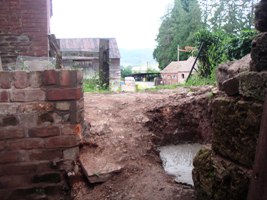Work with tufa stone
28th August 2007
Tufa stone is sometimes referred to as travertine and used to be quarried locally. It is a form of limestone that occurs around springs that are saturated with calcium carbonate and is supposed to be easy to work. We are using old blocks that remain from earlier walls and we find that we can shape the blocks with hand tools but it does take quite a lot of effort. A sharp chisel and a big hammer seem to do the trick but we are convinced that when the text books say it is easy to work they mean easy compared with granite.

The idea is to curve the stone wall away from the tailrace to leave room for steps down into the wheel pit. John and Richard did some digging and a bit of stone cutting to finalise the layout. John finished the end of the wall above the tailrace and laid some concrete footings ready for the masonry.
Elsewhere Headley drilled and tapped all the splints that we need to fit to the cracked wheel spokes. He also loosened the first pair of spoke bolts, a job that requires the application of lots of heat. This is another job that we seem to have been putting off for a while, but whose turn has finally come.
Derek was the fourth and final team member today and he spent the day digging roots out of the area between the mill and the church. Like the rest of us, Derek is never averse to stopping for a chat with any visitors and happily greeted Richard’s family as they dropped in to see what he does with his time.
Richard took the opportunity to try out his prototype ‘Tour Guide’ patter on his niece and nephew, both teenagers, who certainly seemed to enjoy the tour, if not the patter.
Go to the next entry by clicking here.
Read about tufa stone? Click here to see the previous article.
Click here to see how you can support us.
Leave the Shelsey Mill Blog and return Home.